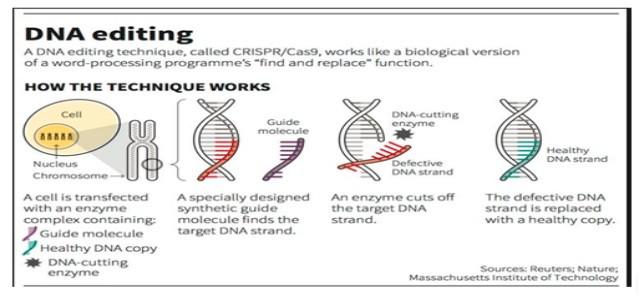Mains Daily Question
Nov. 28, 2023
Q3. Treatment of sickle cell disease underscores the importance of advancing medical research for ultimately finding a cure. In light of the recent advancement made in treatment of sickle cell disease, explain the gene editing therapy along with the challenges involved. (10M/150W)
|
Approach Introduction: Briefly mention about the Sickle Cell Disease and recent advancement in treatment of the disease Heading 1: Explanation of gene editing therapy Heading 2: Challenges Involved Conclusion: Conclude with way forward on how to improve treatment of the disease |
Answer
Sickle cell anemia is a genetic blood disorder characterized by the presence of abnormal hemoglobin, called hemoglobin S (HbS), in red blood cells. This leads to the formation of rigid, sickle-shaped cells that can cause various complications, including pain, anemia, and organ damage. Recently, the United Kingdom became the first country to approve the use of the world’s first gene therapy for treating sickle cell disease and a specific type of sickle cell disease called beta-thalassemia.It may be noted that India ranks as the second most severely impacted nation in terms of anticipated births affected by sickle cell anemia (SCA).
Status of Sickle Cell Anemia in India
Gene editing therapy, particularly using technologies like CRISPR-Cas9, holds promise in treating sickle cell disease by directly addressing the genetic mutation responsible for the condition.
Gene Editing Therapy
- Identifying the Mutation: The specific mutation in the HBB gene that causes sickle cell disease needs to be identified.
- CRISPR-Cas9 Technology: CRISPR-Cas9 is a revolutionary gene-editing tool that allows scientists to precisely modify DNA. In the case of sickle cell disease, researchers can use CRISPR-Cas9 to target the mutated HBB gene.
- Editing the Gene: CRISPR-Cas9 is designed to cut the DNA at the precise location of the mutation. Once the DNA is cut, the cell's natural repair machinery comes into play.
- Natural Repair Process: The cell's repair machinery can introduce the correct genetic sequence to replace the mutated sequence. In the context of sickle cell disease, the goal is to replace the mutated HBB gene with the correct sequence, restoring the normal production of hemoglobin.
- Healthy Hemoglobin Production: With the corrected genetic sequence, the patient's cells can produce normal hemoglobin instead of the abnormal hemoglobin S. This results in the production of normal, flexible red blood cells.
It's important to note that while gene editing therapies, including CRISPR-Cas9, hold immense potential, there are still challenges and ethical considerations that need to be addressed before they can become widely available as a cure for sickle cell disease.
Challenges Involved
- Ethical Considerations: Gene editing therapy presents significant ethical challenges, as altering the genetic code raises questions about the potential misuse of this technology, the creation of designer babies, and the long-term implications of making permanent changes to the human genome.
- Off-Target Effects: One of the major challenges in gene editing therapy is the possibility of unintended genetic modifications, known as off-target effects. Ensuring precision and minimizing these off-target effects is crucial to prevent unintended consequences and potential harm to the patient.
- Long-Term Safety Concerns: The long-term safety of gene editing therapies is a critical concern. Limited understanding of the potential side effects and unforeseen consequences over an individual's lifespan poses a challenge in ensuring the sustained safety and efficacy of gene editing interventions.
- Delivery Mechanisms: Efficient and targeted delivery of gene-editing tools to specific cells or tissues within the body is a technical challenge. Developing reliable and safe delivery mechanisms that can effectively transport gene-editing components to the intended site without causing harm or triggering an immune response is a key hurdle.
Way Forward
Advancing in gene editing technologies, particularly CRISPR-Cas9, requires a comprehensive and collaborative approach. Scientific research and technological refinement should continue to improve the precision and safety of gene editing tools. Ethical considerations demand open dialogue, establishment of clear guidelines, and active engagement with the public to address concerns and promote responsible use. Rigorous testing through clinical trials, coupled with post-market surveillance, is crucial for assessing the safety and efficacy of gene editing therapies. Thus, these measures will significantly contribute to achieving the goal of eliminating sickle cell anemia through a focused mission initiated by India by the year 2047.


